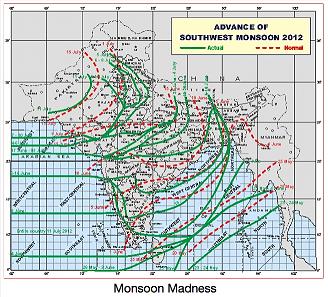
NEW DELHI — Here’s what monsoon season looks like in India. This summer, the northern states have been lashed with rain. In the northeastern state of Assam, July rains swamped thousands of homes, killing 65 residents. Floods and mudslides in northeast India sent nearly 6 million people heading for the hills in search of temporary housing (a tarp, a corrugated roof) and government aid (when they can get it). In New Delhi, the monsoon hasn’t caused anything nearly as traumatic. But one cloudburst can easily flood roads and storm canals, sending bubbling streams of grease and sewage across the urban slums.
 Haven’t heard about all this? Normally, I wouldn't have either. But this semester I’m living in New Delhi, near one of those storm canals, working as a Fulbright-Nehru Research Scholar affiliated with India’s Centre for Policy Research (another “CPR”). My plan is to examine the ways in which Indians are adapting to climate change, at the national, regional, and local levels.
Haven’t heard about all this? Normally, I wouldn't have either. But this semester I’m living in New Delhi, near one of those storm canals, working as a Fulbright-Nehru Research Scholar affiliated with India’s Centre for Policy Research (another “CPR”). My plan is to examine the ways in which Indians are adapting to climate change, at the national, regional, and local levels.
Perhaps no country in the world is as vulnerable on so many fronts to climate change as India. With 7,000 kilometers of coastline, the vast Himalayan glaciers, and nearly 70 million hectares of forests, India is especially vulnerable to a climate trending toward warmer temperatures, erratic precipitation, higher seas, and swifter storms. Then there are India’s enormous cities (home to nearly a third of the population), where all of these trends conspire to threaten public health and safety on a grand scale—portending heat waves, drought, thicker smog layers, coastal storms, and blown-out sewer systems.
Those floods I mentioned earlier are typical of India’s monsoon season—data for this season, in fact, show a monsoon with slightly less total precipitation than normal. But the floods demonstrate the kinds of extreme events that if multiplied in the future will bring even more risk to a fragile country. According to a recent report issued by India’s Ministry of Environment and Forestry, current projections indicate “a 3% to 7% overall increase in all-India summer monsoon rainfall in the 2030’s with respect to the 1970’s.” In contrast, during the winter and pre-summer “dry” season, most regions “are likely to have lower rainfalls.” Such a “barbell effect”—a more extreme wet season joined to a more extreme dry season—could mean trouble for India’s growing cities and struggling rural farmers.
India’s public and private sectors have begun developing adaptation strategies, although most are at the beginning stages. With prodding from the national government, some states are now developing vulnerability assessments and setting priorities. International non-profits like the Rockefeller Foundation are joining with local governments and citizens’ organizations to find better ways to control storm water, irrigate crops, and improve health against the backdrop of a changing climate. Manufacturers, insurance companies, and banks are also examining ways to adapt. This has led to an array of discussions about how public or private initiatives should be used to build resilience in the Indian communities, to make them “climate-ready.” Some of these ideas are particular to India, but many of them will be tested here and exported to the rest of the world, including the United States.
Should rural farmers in India be encouraged to protect against monsoon vagaries by investing in a legalized “weather derivatives” market, like some American hedge funds do? Is there a way that India’s expansive Public Trust Doctrine (inspired by American case law) could be used to protect threatened assets like coastal wetlands and groundwater supplies? Am I nuts to think that a megacity like New Delhi—home to 16 million people, 11 million vehicles, nearly half a million stray dogs, and scores of loitering cows—can coalesce into an environmentally sensible and climate resilient city of the future? Over the coming months, I’ll take on some of these subjects in this blog. I’ll talk with local experts, visit project sites, and venture an assessment or two. As for now, the afternoon thunder is rattling my office window, and I need to find my rubber sandals.

Robert Verchick, Gauthier-St. Martin Chair in Environmental Law, Loyola University, New Orleans. Bio.
| Be the first to comment on this entry. |